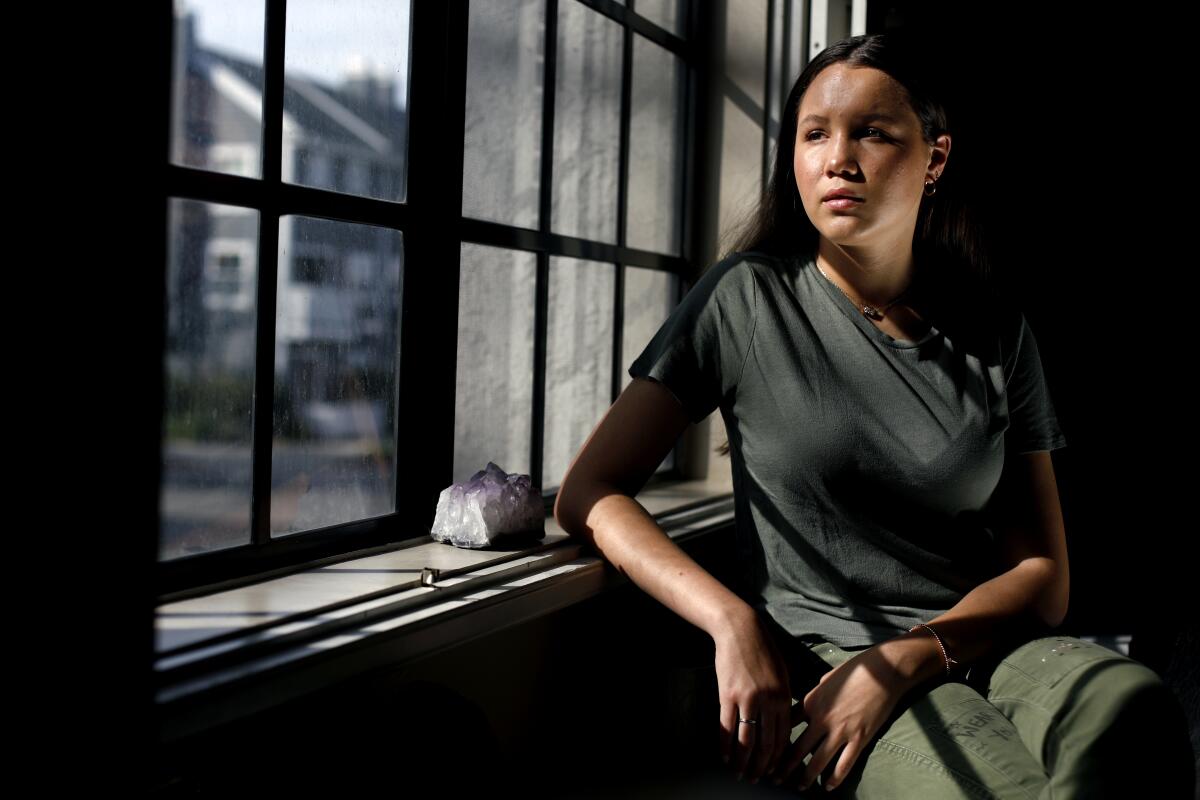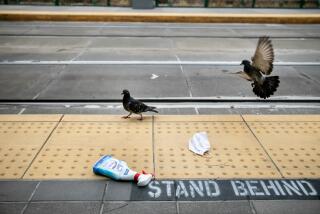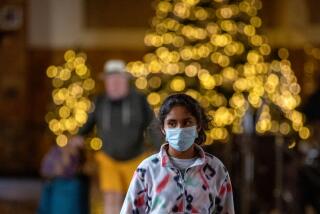As coronavirus outbreak accelerates, youthful faces may mask mortal risk

Grace Rose Bauer buzzed around her Studio City bedroom on a recent sunny afternoon, stuffing her backpack with last-minute supplies for a sleepover at a friend’s house in Beverly Hills. Under her makeup bag and comfy clothes, she had stashed extra bottles of hand sanitizer, packets of antiseptic wipes, and several thousand dollars’ worth of pills.
‚ÄúAs soon as we get to her house, I‚Äôm going to walk to Rite Aid to get Hostess cupcakes,‚ÄĚ the 17-year-old said with a grin. ‚ÄúI don‚Äôt normally like them. But this‚ÄĚ ‚ÄĒ she flashed the blister pack of Trikafta, her new $284-per-dose prescription ‚ÄĒ ‚Äúhas to be digested with fatty food.‚ÄĚ
Bauer has cystic fibrosis, a rare genetic disorder that impairs lung function and can fuel lethal infections from the smallest viral spark. The common cold can send her to the emergency room gasping for breath, as it does millions with asthma. But when it comes to COVID-19, she and others living with chronic illness fear their youthful faces may mask their fragile health.
‚ÄúI‚Äôm sick of everyone saying, ‚ÄėDon‚Äôt worry,‚Äô‚ÄĚ said Lisa Marie Basile, 34, of New York, one of an estimated 6 million Americans who take biologic drugs for autoimmune disease, which makes her far more susceptible to infection. ‚ÄúFriends talk about their parents, their grandparents ‚ÄĒ but there‚Äôs a vast swath of people like me that seem pretty healthy but would probably be No. 1 to go down if they had coronavirus.‚ÄĚ
So far, the international outbreak has largely spared the young, with few serious cases among children and teenagers and no deaths among patients younger than 9. Instead, fatalities have clustered among older adults, concentrating in those with ‚Äúunderlying health conditions.‚ÄĚ
But as the worldwide caseload tops 110,000 and California joins the ranks of states with community transmission, health officials are beginning to caution younger people with respiratory conditions like asthma ‚ÄĒ a disease that occurs disproportionately in children and adolescents ‚ÄĒ as well as in those being treated for autoimmune disease or cancer, which often appear most aggressively in young adults.
‚ÄúIn the past I have definitely been taken down pretty rapidly,‚ÄĚ said author Tiffany D. Jackson, 37, of Brooklyn, who worries her asthma makes her a prime target for COVID-19. ‚ÄúA virus like this that‚Äôs closely related to pneumonia, that‚Äôs an instant killer.‚ÄĚ
In King County, Wash., where the virus has sickened more than 160 and more than 20 have died, health officials have urged people over 60 and those with suppressed immunity and respiratory illnesses to stay home and isolate themselves. But experts say such recommendations are far more difficult for younger people to heed.
As medical and legal advances have helped more people live better and longer, millions now juggle chronic conditions with school, work and childcare ‚ÄĒ roles still largely unrecognized by public health policy.
‚ÄúThey‚Äôre certainly not having their caregiver responsibilities considered,‚ÄĚ said Robyn Powell, a research associate at Brandeis University‚Äôs Lurie Institute for Disability. ‚ÄúAll these recommendations that government officials are making are really unobtainable.‚ÄĚ
Jackson is a good example: Unlike older Americans who can rely on Medicare, she must continue to travel for speaking and teaching engagements to keep up with her hefty healthcare premiums.
‚ÄúIt‚Äôs a double-edged sword,‚ÄĚ Jackson said. ‚ÄúI‚Äôm a solid mid-list author and I supplement my income by doing school visits and conferences. But if I get sick ... I‚Äôd probably lose my insurance within a month.‚ÄĚ
For those who can stay home, worries still abound.
Terri Turnbo, Scarlet Ramirez and Hannah Kaufman all take immuno-suppressant biologic drugs.
All three have tried to isolate themselves as coronavirus has spread, working remotely, concentrating doctors appointments and stocking up on supplies to limit outside errands. Yet all three worry about whether they can safely continue to take their prescriptions ‚ÄĒ not only because biologics reduce their bodies‚Äô resistance to infection, but because insurance protocols make them impossible to stockpile.
‚ÄúI‚Äôm scared to stop taking it but I also want to be mindful of the fact I may not be able to take it,‚ÄĚ said Kaufman, who lives in Chicago. ‚ÄúI‚Äôve tried to space it out as much as I can. I also asked my rheumatologist, can I get a prescription for prednisone,‚ÄĚ a steroid commonly used to reduce inflammation, ‚Äúif I run out.‚ÄĚ
Like the others, Kaufman said she was waiting for advice from her doctors or national health officials. But so far, such guidance has been limited.
‚ÄúHow come nobody‚Äôs talking to us?‚ÄĚ said Turnbo, who recently moved from the Bay Area to Columbus, Ohio. ‚ÄúPeople need to be aware that we‚Äôre out here in the public too.‚ÄĚ
Ramirez was even more blunt.
‚ÄúThey never worry about us until they want to write about our deaths prematurely,‚ÄĚ she said. ‚ÄúIt‚Äôs overwhelming to constantly hear, it‚Äôs only only going to be the elderly. I‚Äôm 42, but thank you for putting in my grave.‚ÄĚ
Advocates say such feelings are increasingly common.
‚ÄúThese are people in the prime of life ‚ÄĒ they‚Äôre not the elderly,‚ÄĚ said Seth Ginsberg, president and co-founder of Creaky Joints, an advocacy group for people with arthritis and rheumatic disease. ‚ÄúPatients are concerned about their welfare and are looking for reassurances. They‚Äôre angry at being ignored.‚ÄĚ
In fact, many said their daily routines have been upended as viral panic has spread, with healthy people hoarding the gloves, surgical masks, hand sanitizer and antiseptic wipes they rely on to protect themselves from more quotidian germs. Not even 8-year-old Audrianna Varner’s favorite Hello Kitty masks have been spared.
‚ÄúI never like to run out because we‚Äôre so on top of these things,‚ÄĚ said mom Candice Varner, whose four other children use wipes, hand sanitizer and the occasional Sanrio face mask to protect their sister, who has cystic fibrosis. ‚ÄúI happened to look on Amazon at the box that I normally buy. Normally I get it for $15.99 and it was $150.‚ÄĚ
Public health officials say masks are most useful for people who already have COVID-19 or are caring for someone sick. Though they may reduce the risk of community transmission, most agree the benefits are marginal compared with hand washing and ‚Äúsocial distancing‚ÄĚ techniques.
Yet, if history is any precedent, the most effective measure of all ‚ÄĒ staying home if you feel sick ‚ÄĒ is the one otherwise healthy Americans seem least likely to heed.
It’s the main reason Lake Balboa second-grader Evaline Garcia can’t go back to school, though she’s doing much better since she began treatment for acute lymphoblastic leukemia last fall.
‚ÄúI keep getting newsletters: another reminder, please don‚Äôt send your kids sick to school,‚ÄĚ mother Jaqueline Garcia said. ‚ÄúMaybe your kid is fine, but you don‚Äôt know if another little kid will get sick and die.‚ÄĚ
Yet she understood why parents did it ‚ÄĒ and why many would probably show up sick to work despite health officials pleading with them to stay home to contain the outbreak.
‚ÄúAt work they offer us five paid sick days, but I have a kid, all of my sick days are for her,‚ÄĚ Garcia said. Many others have no paid sick leave at all.
For those living with chronic illness, learning to survive healthy people’s viral load has been the most effective preparation of all.
‚ÄúYou find ways to deal with‚ÄĚ getting sick, said Jackson, the author. ‚ÄúYou can take all the precautions you want, but it‚Äôs contingent on the precautions others take.‚ÄĚ
More to Read
Sign up for Essential California
The most important California stories and recommendations in your inbox every morning.
You may occasionally receive promotional content from the Los Angeles Times.











